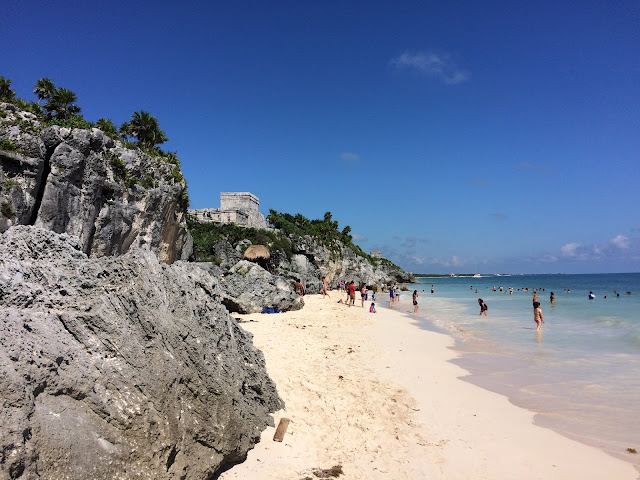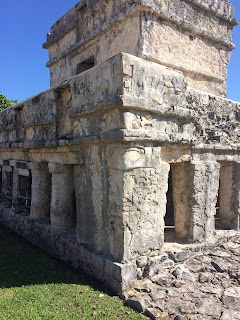Tulum: Paradise by the Sea
Paradise by the Sea
 |
| At the beach |
Journey
The journey here was really easy and simply consisted of flagging a bus down from outside our accommodation in Chichen Itza and then going all the way to Tulum. We hopped off the bus and made our way to the next place we were staying. But we were early, I know right, what is it with these short non-20-hour bus journeys? So we left our bags and went off in search off food, it's what we do best afterall.
 |
| A turtle we found at our accommodation |
The place that we ended up going to was at the other end of town and served the most fantastic burritos! Burrito Amor is named after love and we did indeed love the burritos. We had a vegetable burrito and a bean and cheese burrito. What really made it though were the garlic and chipotle sauces that came with all the goodness. The fresh juice is certainly something we'll miss back in England as well.
 |
| I can see the sea! |
Tulum is a bit of an odd place as there are effectively three sections to it, the ruins, the beach and the town. We spent the rest of our day exploring the town, which largely gives the feel of purely existing for the tourism towards the ruins rather than a town in its own right. Nevertheless we were here and were off to see the ruins the next day
Tulum
 |
| Across the Tulum Ruins |
So off we went down to the coast in order to see the ruins. Tulum is built upon a bluff (a fancy name for a cliff) overlooking the coast. It is thought that it could have been built in order to face the dawn. There's also evidence that it was built there for trade as there is a gap in the Mesoamerican coral reef there which would have allowed ships to come in. The gap lines up with one of the main buildings which could have acted as a lighthouse.
 |
| Olivia making friends |
The ruins were first discovered by the Spanish in 1518 but didn't really come into the public eye in any detail until they were written about by John Lloyd Stephens and Frederick Catherwood in their book Incidents of Travel in Yucatan. They arrived by sea and were really impressed by the stunning sight of the large Castillo building. They made maps of the cities walls and Catherwood made several sketches of the sight. They also found a stele (a flat slab of carved stone that was stood up) inscribed with the date 564, this is now in the British Museum. As the rest of the site dates from between 1200-1450 it's thought that the stele was bought from elsewhere.
 |
| The Carved Temple (complete with big nosed god) |
Upon entering the ruins you start down a track that winds through the trees towards the coast. This is before you get to the city wall which has a little tunnel built into it. Alternatively you can continue around the walls for a little bit to the wind temple that stands on the coast. We were quite pleased to see some dear friends from our time in Iguazu, the little snuffle nosed Coati!
 |
| A coati |
The best part of the site was that there was a little beach break that we could take to cool off in a dip in the sea. Not only is this rather refreshing in the hot sun, it's also a good way to see the ruins perched on the cliffs. The beach was busy but the sea was a nice clear colour and so welcome.
 |
| The Cenote house |
From the ruins we continued a little way up the coast and had a few beers while overlooking the sea. Olivia did a fantastic job of upsetting some people though. I can understand that it is a beautiful sight and everyone wants their photo of themselves in paradise. But it's a little mad the amount of people who are strutting around and doing model poses everywhere. Ultimately you do you, but when you're demanding that everyone gets out of your shot and then take ten minutes to take a photo then you're kind of being a pain. So Olivia is happily walking along the beach (as you do) when on such wannabe model is there posing on the beach and taking five hours to take selfies and photos (across a very public part of the walkway) and if looks could kill I'm sure she'd have murdered Olivia for walking past.
 |
| The wind temple |
But anyway the ruins were amazing and we went back to Tulum town to shower and cool off a little. We also had a milky way bar, which oddly was more akin to a mars bar? But the next day we'd planned to go to a lagoon, however we read online that you weren't allowed to wear suncream in the lagoon which with my pale complexion was going to be a problem. So instead we decided to swim at a cenote instead.
 |
| Ruins by the sea |
This was of course after lunch. We had found a busy and good looking sandwich shop around the corner to try. We ordered a sandwich and I kid you not the thing was a monster! This behemoth was bigger than the plate which was in itself about three hand widths across (if you have hands my size that is). It was huge and filled with meat and sausage, cheese and salad but oh so tasty. So I left there feeling rather full and we ambled up the road to the Cenote. Upon arriving we did however learn that we only had half an hour left to swim, so didn't feel worth it really. But it was alright, as we had exciting things planned for the next day!
Coba
Coba is another ruin located further inland. We had passed it on our way from Chichen Itza and decided that we would return to take a look, having originally considered staying there. We caught a Collectivo from the centre of town and half an hour later we were entering the jungles surrounding the ruins.
My turn to try the Mayan ball game
The site is really early in comparison to the other ruins we had been to, having been set up between 50bc and 100ad. It was also a really massive city in it's prime, stretching something insane like 70km across and even containing a road that reached Chichen Itza. It's reign however slowly died out, before the Spanish arrived, and gave rise to cities such as Tulum. Today we know of Coba due to none other than John Lloyd Stephens and his book on travelling the Yucatan Peninsula (the same guy as above and Chichen Itza).
 |
| one of Coba's ruins |
Coba has a very different feel to the other ruins that we had been to. I think because there is a ban on walking vendors and the site is so spaced out, with there being three sections with about a kilometre between them, it felt somewhat more peaceful. I really enjoyed our visit there and seeing all of the ruins that rose up discreetly through the trees.
 |
| Olivia climbing the pyramid |
My particular favourite part of the ruins however was Ixmoja pyramid in the Nohoch Mul group of buildings. Unlike El Castillo this is a Mayan pyramid that is still climbable. This building is also one of the tallest Mayan pyramids in Mexico. It is incredibly steep, somewhat akin to Huaynu Picchu, but the views from the top are quite incredible. As you climb up the steep steps there comes a point when you break through the tree line and all you can see from the top is a sea of green only rarely punctuated by other buildings that shrink in comparison to this pyramid. It was far scarier going down as you're looking where you could fall. I don't think this was helped by the temple being dedicated to the falling God (in short a god returning to earth) complete with a picture of a man falling head over heels. This may have been a warning?
 |
| The falling god |
But we were successful and made it back to Tulum where we went out for a whopping big club sandwich from our local sandwich shop. I never felt more snake like than trying to figure out how to eat this sandwich, made out of four layered slices of bread with all sorts of things stuffed into it.
 |
| At the top! |
 |
| Enjoying the sun |





Comments
Post a Comment